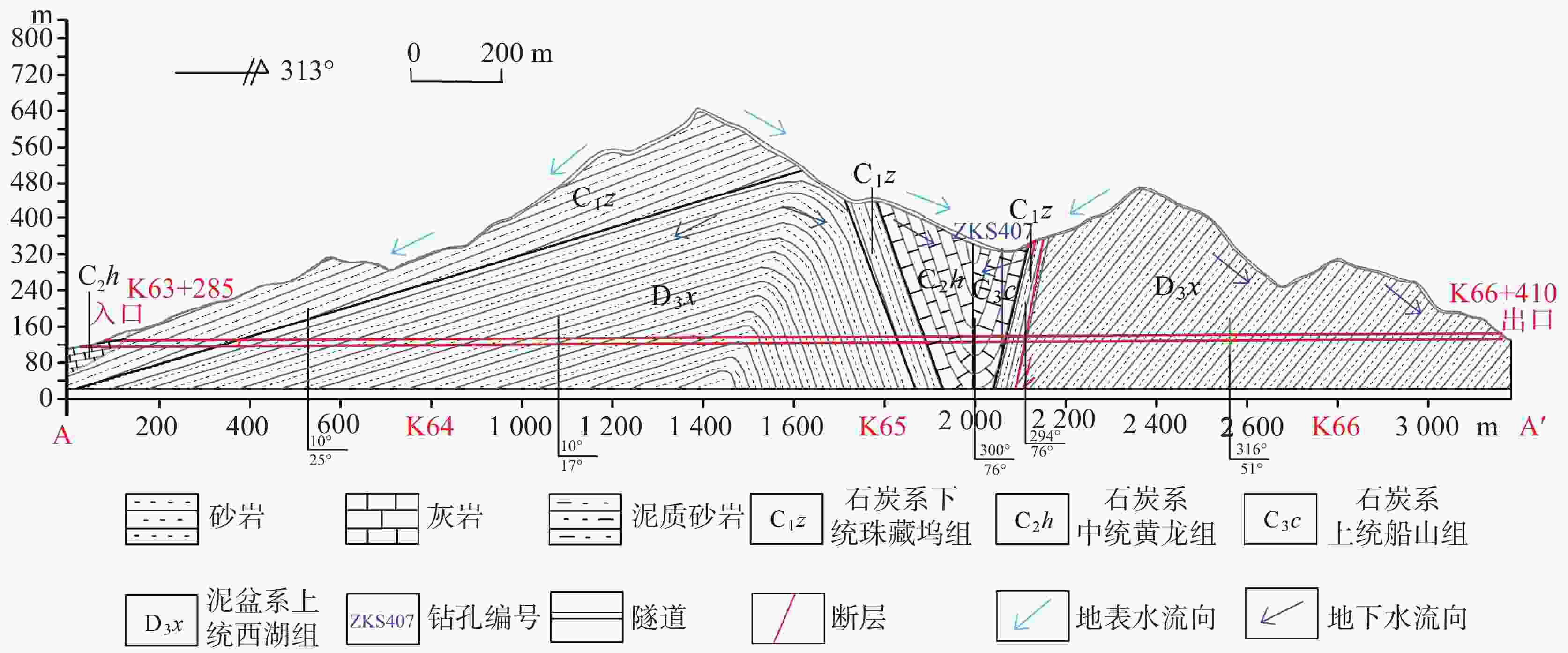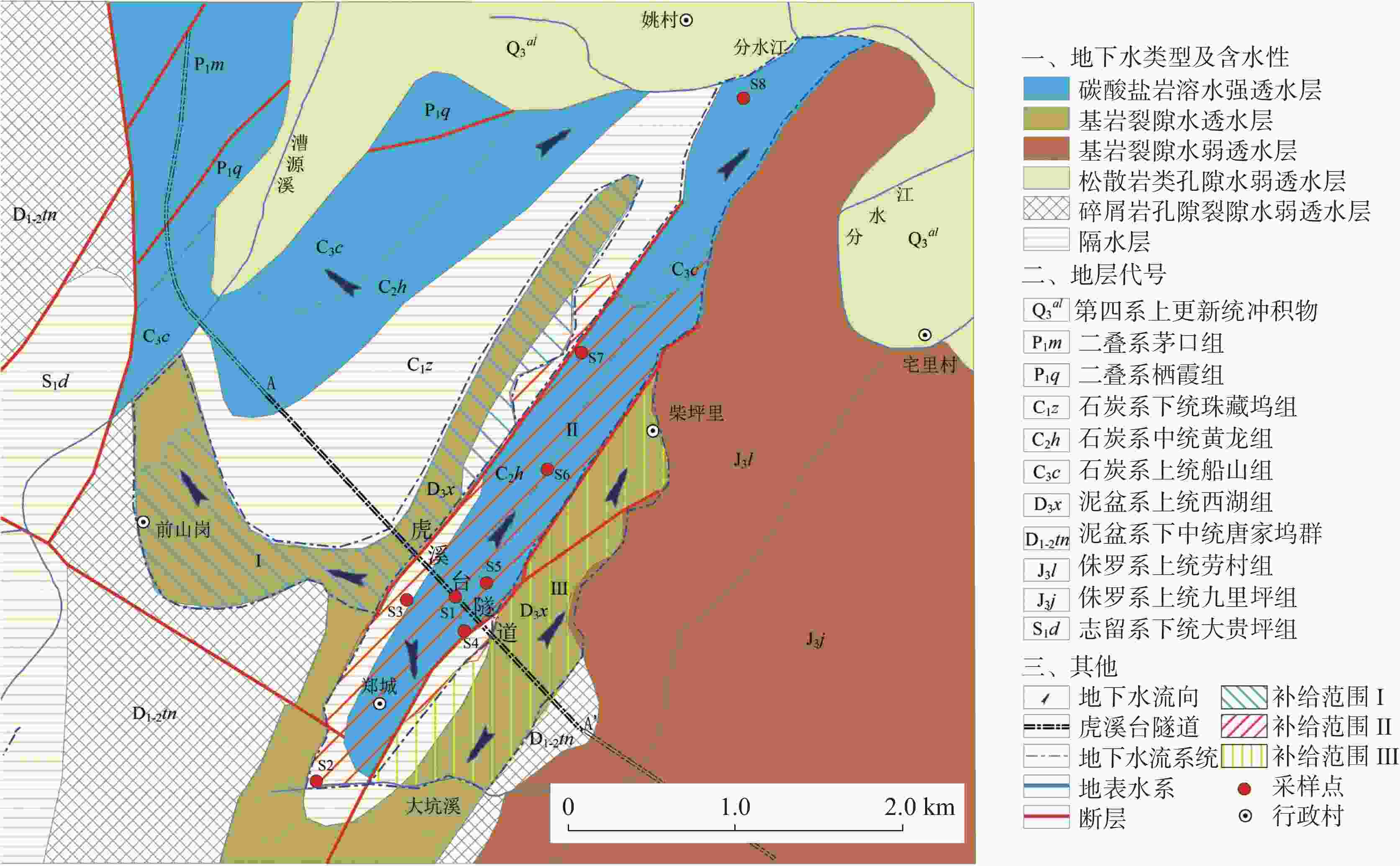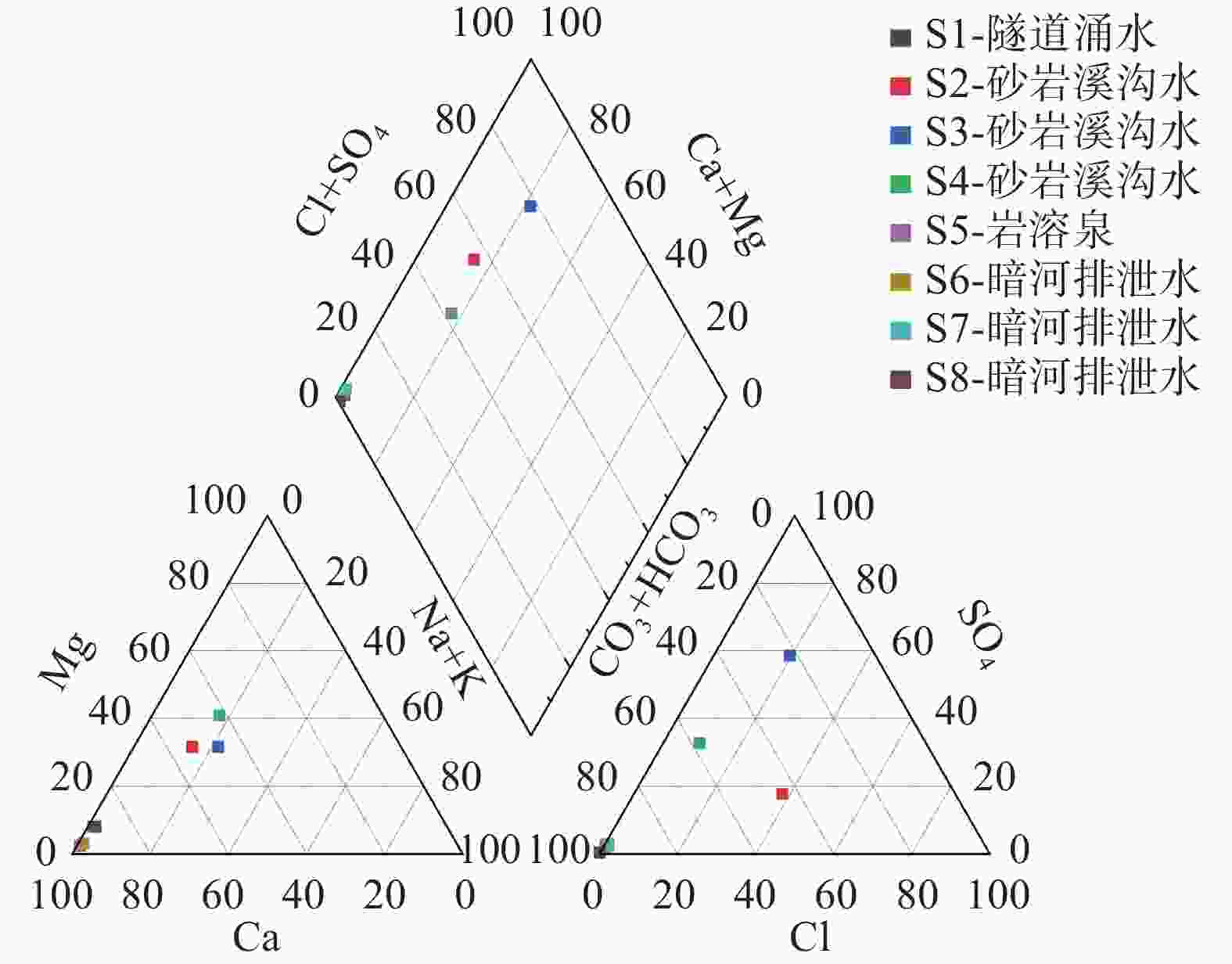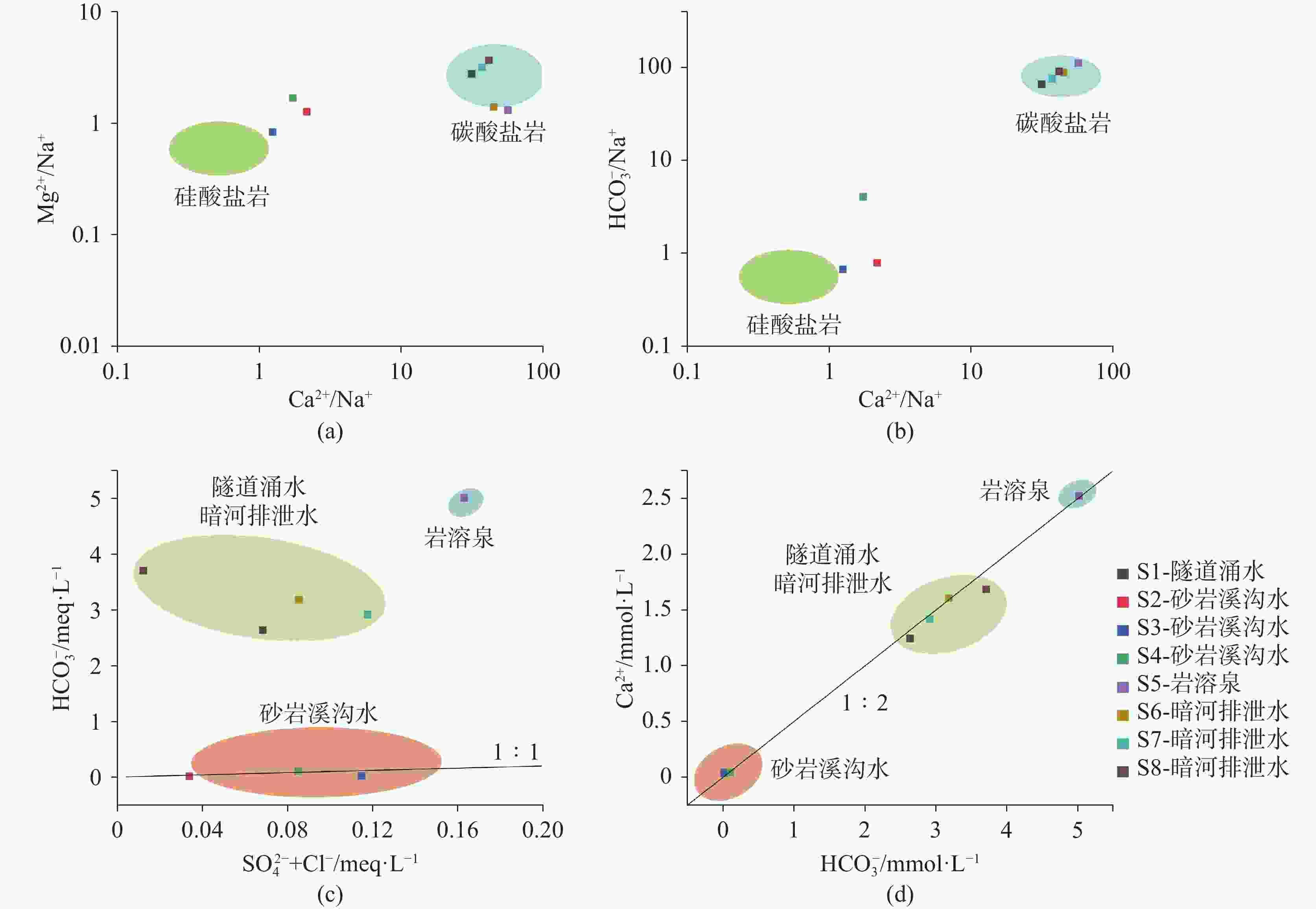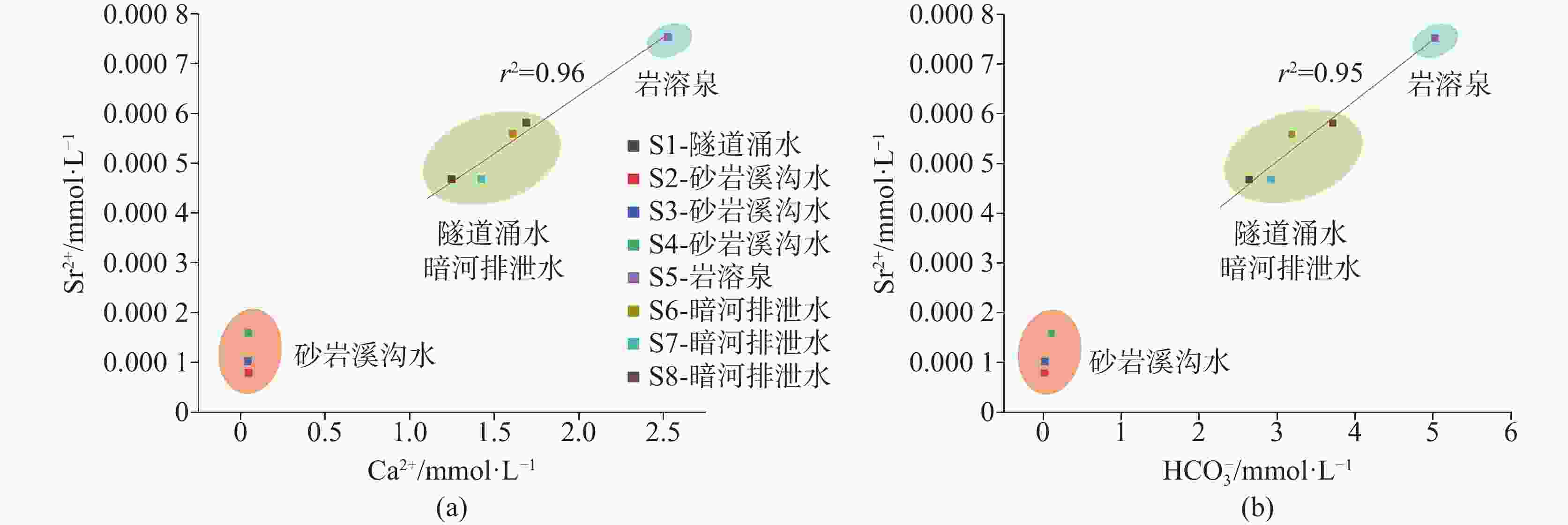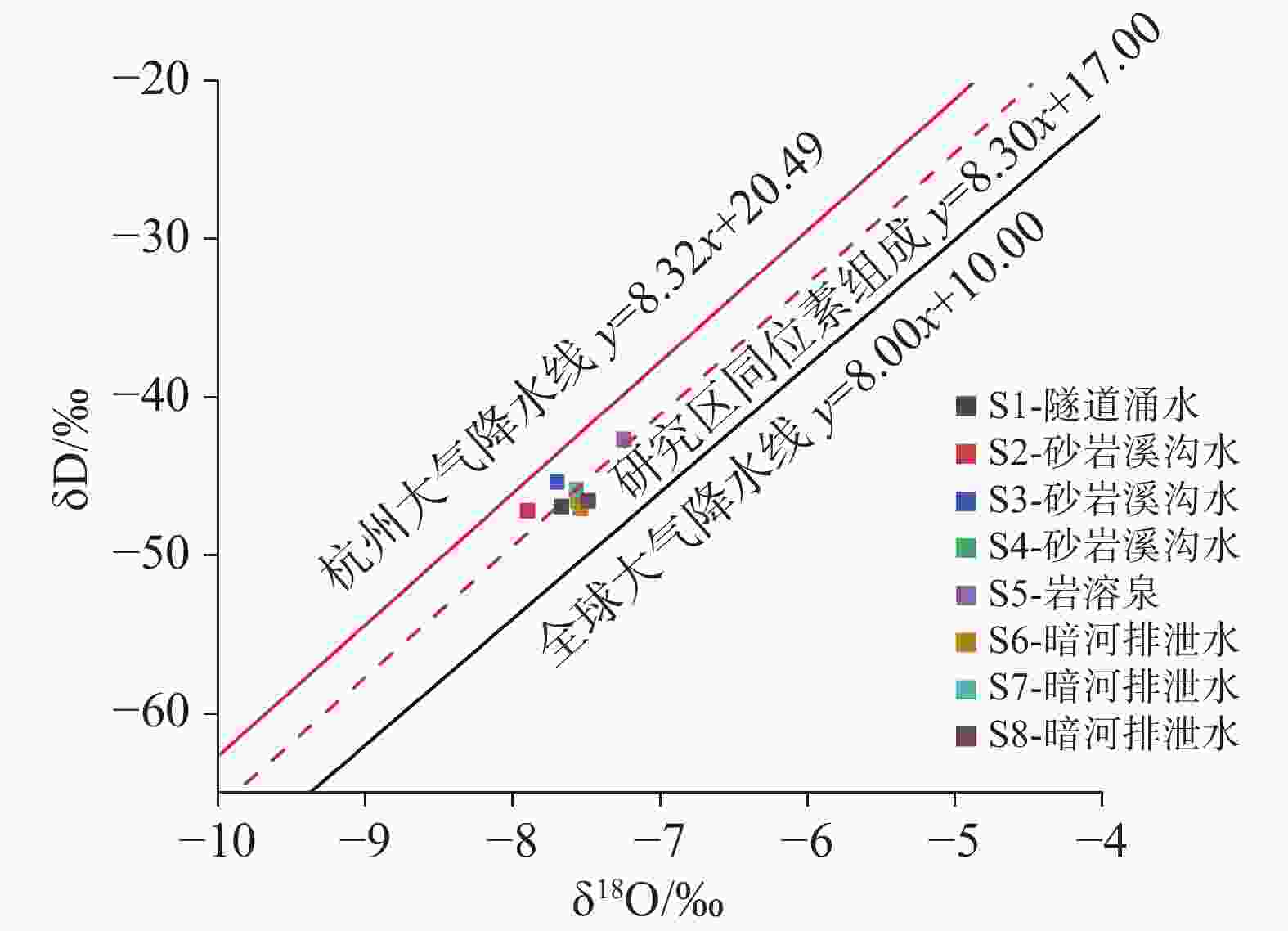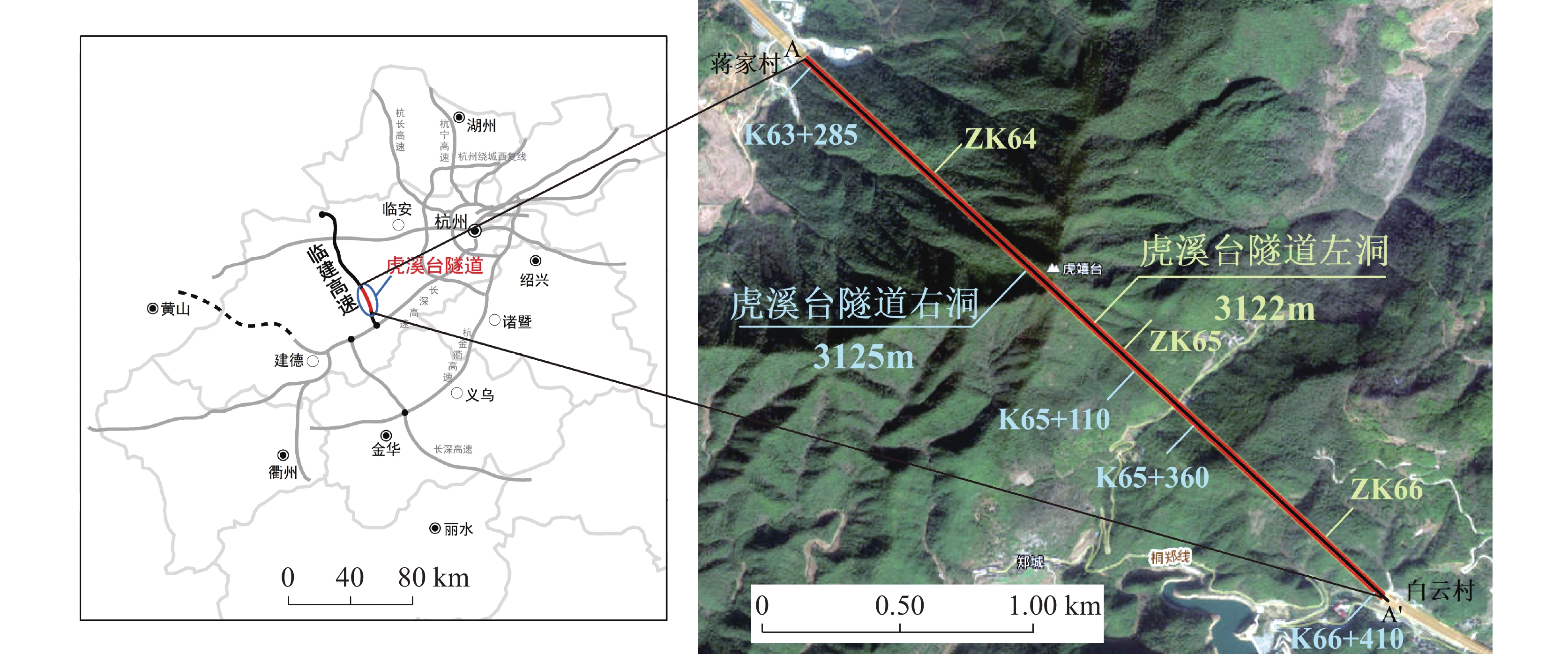Genesis analysis of karst groundwater inrush and prediction of its water inflow in the Huxitai Tunnel
-
摘要: 文章通过对虎溪台隧道详细的野外调查和原位试验,分析其涌水段的水文地质条件,确定地下水流系统,利用地下水的水文地球化学特征,解析岩溶地下水流路径及涌水成因,并预测隧道涌水量。结果表明:(1)隧址区可划分为漕源溪地下水流系统、分水江岩溶地下水流系统和大坑溪—柴坪里地下水流系统;隧道的岩溶涌水段(K65+100—K65+360)位于分水江岩溶地下水流系统中,涌水量大,风险高;(2)隧址区的岩溶地下水主要由大气降水补给,降水通过落水洞和岩溶管道集中补给地下水;隧道涌水的水化学特征与暗河排泄水相似,主要受到碳酸盐岩溶解的影响,表现为岩溶水和砂岩水的混合;隧道的涌水来源于石炭系中统黄龙组和石炭系上统船山组灰岩岩溶水的垂直入渗补给,以及砂岩水的侧向补给;(3)地下水径流过程中,48.29%的地下水通过隧道进行排泄;在没有极端降雨事件的情况下,虎溪台隧道的预测涌水量为
10684.89 m3·d−1,极端降雨事件发生时,预测的最大涌水量可达79364.13 m3·d−1。Abstract:Tunnel water inrush is one of the primary threats to tunnel construction safety, not only posing risks during the construction but also creating long-term hidden dangers for the post-construction operation and maintenance. This issue is particularly severe in karst tunnels, where dense karst fractures and conduit networks will lead to rapid water inrush responses to precipitation. Extreme rainfall events can trigger the instantaneous and massive water influxes, making tunnel water inrush in karst regions especially serious. Therefore, it is critical to elucidate the formation mechanisms of tunnel water inrush and to predict water influxes during extreme rainfall conditions in order to address water inrush challenges and ensure safety of tunnel construction in karst regions. The Huxitai Tunnel is examined here as a case study. This tunnel is a critical component of Linjian Expressway, located in the subtropical humid zone of Eastern China, characterized by abundant preciptation and complex geological conditions.The tunnel tranverses through the Carboniferous Huanglong Formation (C2h) and the Chuanshan Formation (C2c) limestones, which features well-developed karst conduits, abundant water, and high permeability. These features result in significant water inrush problems, increased construction challenges, and heightened safety risks. Since the beginning of tunnel construction, water inrush events in varying degrees have occurred in the limestone sections of the tunnel. To investigate the causes of water inrush in the Huxitai Tunnel under karst geological conditions and to estimate its influxes, this study conducted detailed field investigations and in-situ tests to analyze the hydrogeological conditions of the water inrush sections and to determine the groundwater flow systems. Based on the hydrogeochemical characteristics and hydrogen-oxygen isotopes of groundwater, the study analyzed the pathways of karst groundwater flow and the mechanisms of water inrush. It also estimated the contributions of different water sources to the tunnel water inrush by employing the isotopic end-member mixing model. Using precipitation infiltration methods and groundwater dynamics principles, the study calculated groundwater recharge rates and the proportion of tunnel water inrush relative to total recharge, while predicting the maximum water influx in the tunnel during extreme rainfall events. The findings include as follows. (1) According to the pathways of groundwater flow, the tunnel region is divided into three groundwater flow systems: the Caoyuanxi groundwater flow system, the Fenshuijiang karst groundwater flow system, and the Dakengxi–Chaipingli groundwater flow system. The karst water inrush section (K65+100-K65+360) lies within the Fenshuijiang karst groundwater flow system, which consists of the Huanglong Formation and the Chuanshan Formation limestone characterized by intensive karst development, abundant water influx, and high risks. (2) Karst groundwater in the tunnel area is primarily recharged by precipitation, which infiltrates through sinkholes and karst conduits. The hydrochemical characteristics of tunnel water inrush are similar to those of underground river discharge, dominated by carbonate rock dissolution, reflecting a mixture of karst water and sandstone water. Karst water vertically infiltrating from the Huanglong Formation and the Chuanshan Formation limestone accounts for 70% to 79% of tunnel water inrush, with 21% to 30% contributed by lateral sandstone water. (3) During the runoff process, the recharge of groundwater from atmospheric precipitation amounts to 19,324.89 m3·d−1, of which 48.29% is discharged through the tunnel.Under non-extreme rainfall conditions, the predicted water influx into the Huxitai Tunnel is 10,684.89 m3·d−1; however, during extreme rainfall events, the maximum predicted water influx can reach up to 79,364.13 m3·d−1. To sum up, these results provide a quantitative decision-making basis for the prevention and control of water inrush in the Huxitai Tunnel, and also serve as valuable references for similar studies on water inrush of karst tunnel. -
表 1 研究区水化学及氢氧同位素测试结果
Table 1. Results of hydrochemistry and hydrogen-oxygen isotope tests in the study area
点位 S1 S2 S3 S4 S5 S6 S7 S8 水样类型 隧道岩溶管道涌水 砂岩溪沟水 砂岩溪沟水 砂岩溪沟水 岩溶泉 暗河排泄水 暗河排泄水 暗河排泄水 备注 ZK65+240掌子面 − 灰岩交界 灰岩交界 − − 茅仙洞下洞 − 同位素 δD/‰ −46.91 −47.17 −45.39 −46.57 −42.68 −47.04 −45.86 −46.54 δ18O/‰ −7.67 −7.90 −7.70 −7.56 −7.25 −7.54 −7.57 −7.49 阳离子/
mg·L−1Mg2+ 2.65 0.65 0.66 1.06 1.41 1.21 2.94 3.60 Ca2+ 49.80 1.83 1.64 1.81 101.00 64.30 56.80 67.50 K+ 0.42 0.11 0.11 0.26 0.15 0.26 0.23 0.49 Na+ 0.92 0.49 0.76 0.60 1.03 0.83 0.89 0.94 Sr2+ 0.041 0.007 0.009 0.014 0.066 0.049 0.041 0.051 阴离子/
mg·L−1${\rm{NO}}_3^{-}$ 3.66 7.46 5.05 1.39 2.50 5.80 6.05 0.68 ${\rm{SO}}_4^{2-}$ 2.24 0.51 4.12 3.16 6.39 2.57 4.12 0.57 ${\rm{HCO}}_3^{-}$ 160.83 1.02 1.35 6.51 305.90 194.08 177.90 226.17 Cl− 0.77 0.82 1.02 0.67 1.05 1.12 1.12 0.01 表 2 大气降水入渗法各参数及补给量计算结果
Table 2. Calculation results of parameters and recharge of atmospheric precipitation infiltration method
涌水段 α Wmax/mm A/km2 Q极端/m3·d−1 K65+100—K65+360 0.3 246.40 2.15 158928.00 表 3 地下水动力学法各参数及涌水量计算结果
Table 3. Calculation results of parameters and water influx of groundwater dynamics method
涌水段 K65+100—K65+360 L/m 260.00 K/m·d−1 0.0864 H/m 260.00 h/m 254.00 d/m 11.00 Q灰岩岩溶水/m3·d−1 8067.09 Q砂岩水/m3·d−1
Q/m3·d−12617.80 10684.89 表 4 极端降雨条件下隧道最大涌水量计算结果
Table 4. Calculation results of maximum water influx in the tunnel under extreme rainfall conditions
涌水段 Q补给/m3·d−1 η Qmax/m3·d−1 K65+100—K65+360 19324.89 0.4829 79364.13 -
[1] 张鹏, 潘晓东, 任坤, 骆伟, 马德青, 彭聪, 杨杨. 岩溶台地深埋特长隧道岩溶水流特征及涌水评估[J]. 公路, 2022, 67(2): 337-345.ZHANG Peng, PAN Xiaodong, REN Kun, LUO Wei, MA Deqing, PENG Cong, YANG Yang. Characteristics of karst water flow in deeply buried long tunnel on karst plateau and assessment of water inrush[J]. Highway, 2022, 67(2): 337-345. [2] 李志源, 王维富, 徐学存. 岩溶隧道涌水来源及对地下水环境的影响[J]. 铁道建筑, 2020, 60(9): 78-82.LI Zhiyuan, WANG Weifu, XU Xuecun. The source of karst tunnel water inflow and its impact on groundwater environment[J]. Railway Engineering, 2020, 60(9): 78-82. [3] 罗一鸣, 成建梅, 徐文杰, 巴净慧, 黄盛财, 段天宇. 西南岩溶区深埋隧洞涌水条件分析及涌水量预测: 以滇中引水工程大坡子隧洞为例[J]. 中国岩溶, 2023, 42(6): 1224-1236.LUO Yiming, CHENG Jianmei, XU Wenjie, BA Jinghui, HUANG Shengcai, DUAN Tianyu. Analysis of water inflow conditions and prediction for water inflow of deep-buried tunnels in the karst area of Southwest China: Taking Dapozi tunnel of central Yunnan Water Diversion Project as an example[J]. Carsologica Sinica, 2023, 42(6): 1224-1236. [4] 武亚遵, 万军伟, 林云, 蔡二贝. 基于岩溶演化模型的隧道突水危险性评价[J]. 地质科技通报, 2015, 34(5): 166-171,179.WU Yazun, WAN Junwei, LIN Yun, CAI Erbei. Risk evaluation of water inrush in karst tunnel based on karst evolution model[J]. Bulletin of Geological Science and Technology, 2015, 34(5): 166-171,179. [5] 郑克勋, 裴熊伟, 朱代强, 吴述彧, 郭维祥. 岩溶地区地下水位变动带隧道涌水问题的思考[J]. 中国岩溶, 2019, 38(4): 473-479.ZHENG Kexun, PEI Xiongwei, ZHU Daiqiang, WU Shuyu, GUO Weixiang. Thoughts on tunnel water inrush in changing zones of groundwater level in karst areas[J]. Carsologica Sinica, 2019, 38(4): 473-479. [6] 林永生, 邹胜章, 朱丹尼. 岩溶隧道涌水原因揭秘[J]. 中国矿业, 2020, 29(S1): 582-583,586.LIN Yongsheng, ZOU Shengzhang, ZHU Danni. The causes of water bursting in karst tunnel[J]. China Mining Magazine, 2020, 29(S1): 582-583,586. [7] 冯雪冬, 周小龙, 胡亚晴. 岩溶地区隧道突涌水机理的研究进展[J]. 武汉工程大学学报, 2022, 44(3): 250-259,354.FENG Xuedong, ZHOU Xiaolong, HU Yaqing. Research progress in water inrush mechanisms of tunnels in karst area[J]. Journal of Wuhan Institute of Technology, 2022, 44(3): 250-259,354. [8] 李潇, 漆继红, 许模. 西南典型紧窄褶皱小尺度浅层岩溶水系统特征及隧道涌水分析[J]. 中国岩溶, 2020, 39(3): 375-383.LI Xiao, QI Jihong, XU Mo. Analysis on the characteristics of small-scale shallow karst water systems in typical tight-narrow folds and tunnel water inrush in southwestern China[J]. Carsologica Sinica, 2020, 39(3): 375-383. [9] 徐啸川, 徐光黎, 魏文豪, 李溢渊, 薛媛. 示踪实验在湾潭隧道涌水突泥判别中的应用[J]. 地质科技通报, 2023, 42(2): 297-304.XU Xiaochuan, XU Guangli, WEI Wenhao, LI Yiyuan, XUE Yuan. Application of a tracing experiment in the prediction of water and mud inrush in the Wantan Tunnel[J]. Bulletin of Geological Science and Technology, 2023, 42(2): 297-304. [10] 罗明明, 周宏, 郭绪磊, 陈乾龙, 齐凌轩, 况野. 峡口隧道间歇性岩溶涌突水过程及来源解析[J]. 地质科技通报, 2021, 40(6): 246-254.LUO Mingming, ZHOU Hong, GUO Xulei, CHEN Qianlong, QI Lingxuan, KUANG Ye. Processes and sources identification of intermittent karst water inrush in Xiakou Tunnel[J]. Bulletin of Geological Science and Technology, 2021, 40(6): 246-254. [11] 邵长杰, 曾斌, 徐国锋. 金华山隧道涌水对双龙洞景区岩溶泉影响分析[J]. 中外公路, 2020, 40(S2): 199-203.SHAO Changjie, ZENG Bin, XU Guofeng. Analysis of the impact of water inflow from Jinhuashan tunnel on karst springs in Shuanglong cave scenic spot[J]. Journal of China & Foreign Highway, 2020, 40(S2): 199-203. [12] 彭红明, 袁有靖, 李铜邦, 董高峰, 刘毅, 巴瑞寿. 青海天峻新关角隧道涌排水水源识别与量化分析[J]. 地质科技通报, 2022, 41(1): 60-70.PENG Hongming, YUAN Youjing, LI Tongbang, DONG Gaofeng, LIU Yi, BA Ruishou. Identification and quantitative analysis of groundwater discharged from Xinguanjiao tunnel in Tianjun, Qinghai[J]. Bulletin of Geological Science and Technology, 2022, 41(1): 60-70. [13] 罗明明, 黄荷, 尹德超, 周宏, 陈植华. 基于水化学和氢氧同位素的峡口隧道涌水来源识别[J]. 水文地质工程地质, 2015, 42(1): 7-13.LUO Mingming, HUANG He, YIN Dechao, ZHOU Hong, CHEN Zhihua. Source identification of water inrush in the Xiakou tunnel based on hydrochemistry and hydrogen-oxygen isotopes[J]. Hydrogeology and Engineering Geology, 2015, 42(1): 7-13. [14] 刘常昊, 郑万波, 吴燕清, 杨志全, 丁力生, 杨黎明, 史耀轩. 玉磨铁路景寨隧道富水段涌水量预测方法[J]. 安全与环境工程, 2022, 29(4): 66-73.LIU Changhao, ZHENG Wanbo, WU Yanqing, YANG Zhiquan, DING Lisheng, YANG Liming, SHI Yaoxuan. Prediction method of water inflow in the Fushui section of Jingzhai tunnel of Yumo railway[J]. Safety and Environmental Engineering, 2022, 29(4): 66-73. [15] 常威, 谭家华, 黄琨, 程烯, 黄镇, 万军伟. 地下水多元示踪试验在岩溶隧道水害预测中的应用: 以张吉怀高铁兰花隧道为例[J]. 中国岩溶, 2020, 39(3): 400-408.CHANG Wei, TAN Jiahua, HUANG Kun, CHENG Xi, HUANG Zhen, WAN Junwei. Application of groundwater multi-element tracing tests to water hazard prediction of karst tunnels: An example of the Lanhua tunnel on the Zhangjiajie-Jishou-Huaihua high-speed railway[J]. Carsologica Sinica, 2020, 39(3): 400-408. [16] 沈东东. 乐广高速岩溶隧道稳定性及突涌水研究[D]. 武汉: 中国地质大学(武汉), 2011.SHEN Dongdong. Study and evaluate of stability and water gushing of surrounding rockmass in karst area tunnel in Leguang freeway[D]. Wuhan: China University of Geosciences(Wuhan), 2011. [17] 吴春勇. 鄂尔多斯白垩系盆地地下水水化学演化的同位素示踪研究[D]. 长春: 吉林大学, 2011.WU Chunyong. Isotopic constraints on hydrochemical evolution of groundwater in the Ordos Cretaceous Basin[D]. Changchun: Jilin University, 2011. [18] 张俊锋, 李强, 史永跃, 吴磊. 西南某隧道岩溶水发育规律及涌水量预测[J]. 现代隧道技术, 2021, 58(2): 14-21.ZHANG Junfeng, LI Qiang, SHI Yongyue, WU Lei. On development law of karst water and prediction of water inflow in a tunnel in Southwest China[J]. Modern Tunnelling Technology, 2021, 58(2): 14-21. [19] Jin Z, Wang Y, Li F, Qian L, Hu Y, Shi Y. Stable isotopes and chemical characteristics of precipitation in Hangzhou and Huzhou, East China[J]. Environmental Science and Pollution Research, 2019, 26(7): 23717-23729. [20] 范威, 王川, 金晓文, 胡德勇, 陈植华. 吉莲高速公路钟家山隧道涌突水条件分析[J]. 水文地质工程地质, 2015, 42(2): 38-43,51.FAN Wei, WANG Chuan, JIN Xiaowen, HU Deyong, CHEN Zhihua. Water inrush condition analysis of the Zhongjiashan tunnel in the Jilian highway[J]. Hydrogeology and Engineering Geology, 2015, 42(2): 38-43,51. [21] 郑齐. 王家山隧道水文地质条件分析及涌水量的预测[J]. 黑龙江交通科技, 2022, 45(11): 111-113.ZHENG Qi. Analysis of hydrogeological conditions and prediction of water inflow in Wangjiashan tunnel[J]. Communications Science and Technology Heilongjiang, 2022, 45(11): 111-113. [22] 陈瑜林. 西南地区岩溶隧道涌水量统计分析计算[D]. 成都: 成都理工大学, 2018.CHEN Yulin. Statistical analysis and calculation of water flow in southwestern karst tunnel[D]. Chengdu: Chengdu University of Technology, 2018. [23] 常威. 复杂岩溶水系统识别及其在隧道涌水量预测的应用研究[D]. 武汉: 中国地质大学(武汉), 2021.CHANG Wei. Study on the identification of complex karst water systemand its application in tunnel water disaster prediction[D]. Wuhan: China University of Geosciences(Wuhan), 2021. [24] 陈明浩, 邓宏科, 张广泽, 付开隆. 昭通隧道岩溶水文地质特征及突涌水危险性评价[J]. 高速铁路技术, 2020, 11(6): 34-39.CHEN Minghao, DENG Hongke, ZHANG Guangze, FU Kailong. Analysis of karst hydrogeological characteristics and risk assessmentof water inrush for the Zhaotong tunnel[J]. High Speed Railway Technology, 2020, 11(6): 34-39. [25] 田祖涛, 张俊. 花梨隧道岩溶水文地质条件及危险性评估[J]. 中国岩溶, 2019, 38(4): 552-558.TIAN Zutao, ZHANG Jun. Karst hydrogeological conditions and hazard assessment of Huali Tunnel[J]. Carsologica Sinica, 2019, 38(4): 552-558. [26] 齐国庆. 红崖山岩溶隧道突水危险性分析与涌水量预测研究[D]. 重庆: 重庆交通大学, 2021.QI Guoqing. Study on the hazard analysis of water inrush and the prediction of water inflow in Hongyashan karst tunnel[D]. Chongqing: Chongqing Jiaotong University, 2021. [27] 傅鹤林, 安鹏涛, 伍毅敏, 李鲒, 陈龙. 富水裂隙围岩隧道涌水量计算方法与规律分析[J]. 哈尔滨工业大学学报, 2024, 56(3): 110-116.FU Helin, AN Pengtao, WU Yimin, LI Jie, CHEN Long. Calculation method and law analysis of water inflow in tunnel under water-rich fissure surrounding rock[J]. Journal of Harbin Institute of Technology, 2024, 56(3): 110-116. [28] 黄启艳. 富水破碎砂岩隧道涌水预测及施工治理措施研究[J]. 铁道建筑技术, 2024(7): 166-168,185.HUANG Qiyan. Study on prediction and construction measures for water gushing in fractured sandstone tunnel with abundant water[J]. Railway Construction Technology, 2024(7): 166-168,185. [29] 李清波, 闫长斌. 岩体渗透结构类型的划分及其渗透特性研究[J]. 工程地质学报, 2009, 17(4): 503-507.LI Qingbo, YAN Changbin. Classification of permeablity structure types of rock mass and its permeability characteristics[J]. Journal of Engineering Geology, 2009, 17(4): 503-507. -




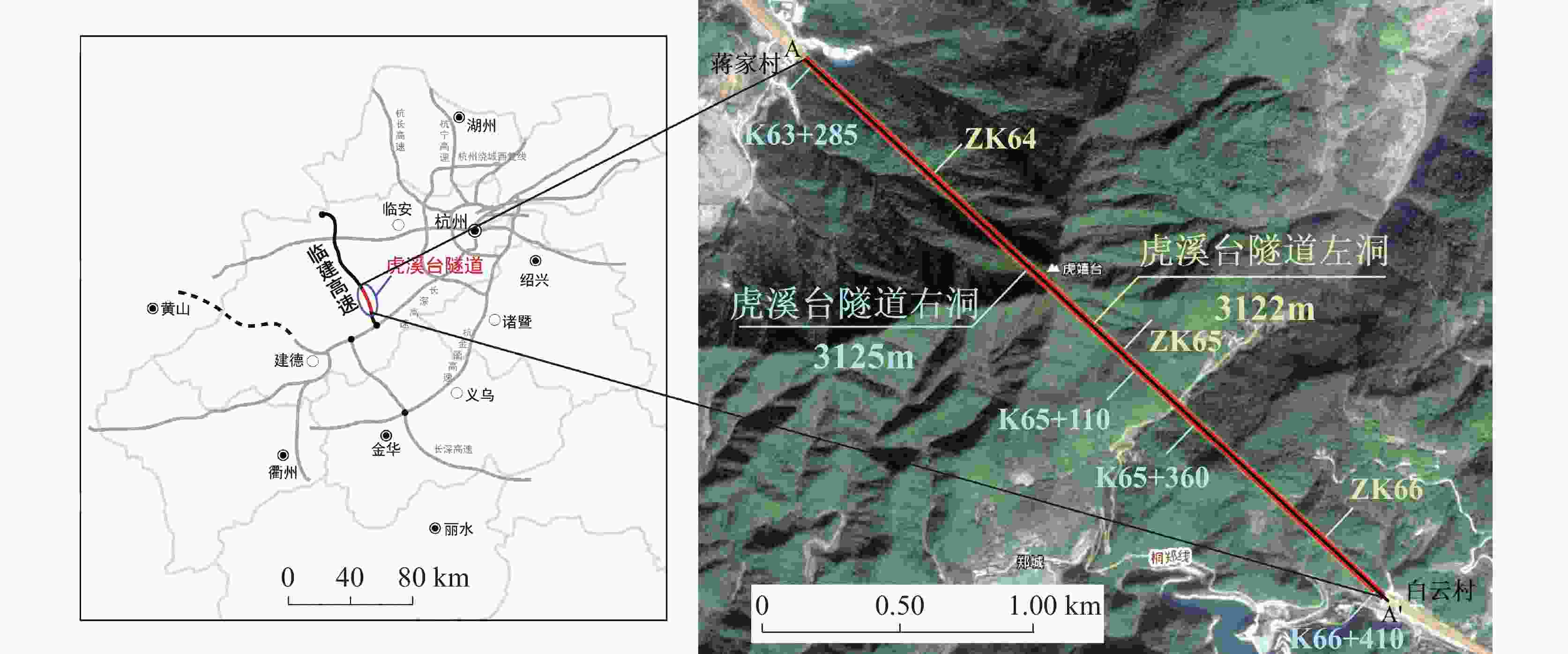
 下载:
下载:
